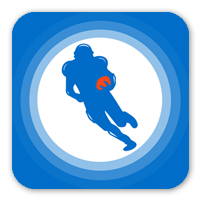Corbin analyzes torpedo bats, and potential fantasy baseball breakout power hitters by looking at Statcast data like bat speed, swing length, squared-up rate, and blasts.
The hot topic over the past week has been torpedo bats, with the Yankees' hitters being the focal point. Over the past two seasons, we have more Statcast data on bat speed, swing length, squared-up rate, and blasts. The latter two relate to the contact efficiency from the bat, plus bat speed and exit velocity.
After listening to a recent Rates and Barrels Podcast with Keenan Long of Longball Labs, it became evident that the terminology, data, and information about bats can be specific to a player and more complex than we realize. One comment from Long that stuck with me involves information beyond bat fitting and assessing which bat would work best, since there's variation in the wood and the creation of the "golden bat," as they referenced that perfect fit during the assessment phase.
Unsurprisingly, Eno Sarris researched bats in 2021 for an article in The Athletic. Without spoiling the article, there was a reference to players being surprised at the variations in their bats, even if they had been listed as the same lengths and weights. Some differences involved how the bat felt during swings, exit velocity, and visible differences, hence Sarris's title "No two trees are alike." Furthermore, when considering the weather, humidity, and many other factors, it adds variability in the bat, contact quality, and physics information that's beyond my expertise. That's important context as we examine some bat speed and bat tracking data, since that's what we have to work from, since the Yankees smashed home runs to begin the season.
Be sure to check all of our fantasy baseball lineup tools and resources:- Fantasy baseball trade analyzer
- BvP matchups data (Batter vs. Pitcher)
- PvB matchups data (Pitcher vs. Batter)
- Who should I start? Fantasy baseball comparisons
- Daily MLB starting lineups
- Fantasy baseball closer depth charts
- Fantasy Baseball live scoreboard
- Fantasy baseball injury reports
Team-Level Data: Bat Speed and Barrels
Last season, the Yankees ranked fifth in team-level bat speed (72.1 mph), tying them with the Royals. The Yankees hit the most barrels (410), over 30 more than the Braves (372) in second. Unsurprisingly, they led the league in barrels per plate appearance (9.5 percent) in 2024. The "Grand Total" is the average across the past three seasons.
The Yankees rank third in bat speed (72.6 mph), behind the Mets and Cardinals in 2025. They rock an 82.6 percent home run per barrel rate. For context, the league average was 56.1 percent in 2024, so they've been uber-efficient in hitting home runs.
Like any data set, a few players could cause it to swing in either direction. For instance, having Giancarlo Stanton and Aaron Judge boosted the Yankees' hitters, but the additions of Jazz Chisholm Jr. and Cody Bellinger matter too.
Besides bat speed and the bat tracking data, exit velocity matters, specifically Exit Velocity 50. We discussed EV50 in more depth in my latest off-season article because it correlates well with barrels and barrels per plate appearances. That's notable because when we toss aside the bat types, the exit velocity numbers we have access to might be more relevant for fantasy purposes, like EV50.
Statcast Data: Blasts and Squared-Up Rate
The average bat speed in 2024 was 71.1 mph. Bat speed correlated the best with average exit velocity (.503) and less so with barrels per plate appearance (.306). However, bat speed wasn't great at predicting home runs (0.074). That's somewhat surprising, though a hitter could swing the bat hard, but it doesn't translate to home runs based on the squared-up rate and other metrics.
Before we dive into the player-specific bat-tracking data, let's define terms. Statcast defines squared-up rate as "how much of the highest possible exit velocity available" the batter obtained with their swing. The percentage comes from how much exit velocity was feasible based on the swing and pitch speeds.
So, if a player has a 70 percent squared-up rate, it indicates that they attained 70 percent of their maximum possible exit velocity based on swing and pitch speeds. The squared-up rate measures the contact efficiency.
Furthermore, a squared-up swing with fast bat speed typically leads to a blast, which combines harder swings and efficient contact (squared-up rate). Unsurprisingly, blasts have near-elite outcomes via production, exit velocities, and barrels. Let's look at the hitter leaders from 2024 while highlighting the 2025 numbers, though it's a small sample.
Stanton entered the 2025 season injured, and it's mind-blowing to see his bat speed data and the difference between the hitters behind him. Though we didn't discuss and define this metric, Statcast has a hard swing rate, which is the percentage of swings 75 mph or higher.
Stanton had 98.6 percent of his swings be 75 mph or higher. The next highest hitter was Kyle Schwarber, with a hard swing rate 20 percentage points behind Stanton. Theoretically, that time of swing intensity could lead to injuries, similar to pitch velocity.
Yankees Hitters and Bat Speed Data
When looking at the Yankee hitters from 2024, plus the two notables from 2025 in Chisholm Jr. and Bellinger, Judge and Stanton unsurprisingly have the best bat speed metrics. Bellinger squared up the ball at an above-average rate, showing he efficiently attained over 38 percent of his possible exit velocity.
Anthony Volpe made more contact (75 percent) and traded power (80 Expected Power Index, xPX) compared to 2023. Volpe saw a six percentage point increase in contact rate (69 percent) and a 30-point decline in xPX (112). He lost over one mph of bat speed in 2024 (69.3 mph) compared to the second half of 2023 (70.9 mph), since that's the earliest bat tracking data in Savant.
Among all Yankee hitters in the early 2025 sample, Volpe's bat speed jumped to a career-best at 71.2 mph. He has been efficient with his three barrels and three home runs in 2025, and bat types and speeds remain only one puzzle piece, as discussed earlier.
Bat speed correlates well with hard swing rate (.921), which Statcast defines as swings at 75 mph or higher. Volpe boasts a hard swing rate of 20 percent in the small 2025 sample compared to 9.1 percent (2023) and 3.7 percent (2024). Unsurprisingly, with Volpe swinging harder and adding bat speed, his rate of blasts per contact has increased to a career-best 17.4 percent, over four percentage points above the league average (14.3 percent).
Like Volpe, Bellinger flashed bat speed gains (71.4 mph) and hard swing rate improvements (7.8 percent) compared to the previous two seasons of data. Bellinger historically has one of the longer swings, aligning with what we see on film, and it became longer in the small 2025 sample at 7.84 feet. That's about two-to-three inches longer than in 2023 and 2024.
The visual below shows the hitters who saw an increase in bat speed of two mph or more in 2025.
Bellinger hasn't been squaring the ball up as much in 2025, though we've seen his blast per contact rate increase, meaning he squares up the ball with higher bat speed and exit velocities. That's a fruitful combination for Bellinger, as one of my bold predictions for him to hit 40 home runs.
Paul Goldschmidt has maintained his bat speed over the past three seasons, but his hard swing rate fluctuated, with a career-low (11.5 percent) in the early 2025 small sample. If we had more bat speed data, we would expect a hitter's bat speed and hard swing rate to decline throughout their careers. Interestingly, Goldschmidt showed a higher squared-up percentage in 2025 while maintaining his blasts per contact rate.
Summary
Over the past three seasons with bat speed data, the 2025 Yankees ranked fourth among all teams throughout the previous years. Unsurprisingly, the Yankees have had the highest bat speed in the past three years. Judge and Stanton play a role in the inflated bat speed, but it could be a team philosophy.
Do the bats matter for the Yankees and other players? Somewhat, but other factors matter like bat speed, hard swing percentage, squared-up rate, and blasts among the data we access. Though the torpedo bats might be gaining steam in the headlines, we have an idea of what matters for fantasy purposes, as we mentioned earlier, with bat speed and hard swing rate impacting those outcomes, including barrels, home runs, and blasts.
I'll need to revisit this topic with bat speed data once we gather more information in 2025.
Download Our Free News & Alerts Mobile App
Like what you see? Download our updated fantasy baseball app for iPhone and Android with 24x7 player news, injury alerts, sleepers, prospects & more. All free!

More Fantasy Baseball Advice





 RADIO
RADIO





























